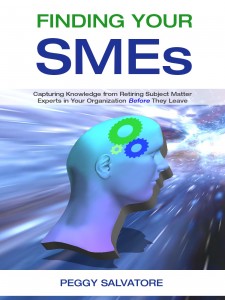I love doing live workshops, webinars and seminars because the questions and discussions are usually a great place to further explore the subject matter of subject matter experts. A discussion at a Working with SMEs workshop the other day led to an issue that deserves a quick mention – and that is, how do you know if you are working with a true subject matter expert or if you are dealing with a poser?
Let’s define our terms, and that will get us where we need to go pretty quickly.
A subject matter expert (SME) is somebody who has dedicated about 10,000 hours to learning a subject. In working years, that translates into about five full-time years of effort. People who earn PhD’s, for example, dedicate effort to research and working in a very small area of study for least as many years. They are expected to be able to defend what they know to a jury of their peers and then write several hundred pages of documented effort showing their work. A Harvard Business Review article from 1989, The Experts in Your Midst by Michael J. Prietula and Herbert A Simon, defines a SME as someone who is analyzing and applying about 50,000 disparate pieces of information in their head at one time. It goes mostly without saying, but I’ll say it anyway, they know their subject well enough that their analysis and ability to problem solve is mostly happening at a subconscious level.
An expert in business and industry who hasn’t earned an official PhD might have dedicated 5, 10 or 20 years perfecting their craft at a machine that manufactures a specific item or part, or by learning from their customers while meeting their needs. That’s true expertise, too.
What is a poser? For that, I defer to Merriam Webster. Definition #2 is “a person who poses.” The etymology of the word is “pose” and the first known use is 1888. A person who poses as a subject matter expert is not a subject matter expert but is donning the position. How do you know if that is what you are dealing with?
One of my mentors, the late turnaround artist Elmer Gates, could sniff them out pretty quickly. When he took over a company, he called his direct reports into his office and asked them some basic questions about their lines of business such as how to defend their sales projections. He asked detailed questions about their customers’ businesses. If they didn’t have the hard data, he asked them to go find it. When his direct reports drilled down into the organization and found the answers, the actual knowledge usually resided one or two levels down.
Your actual experts are doing the work every day. They understand their machines, they understand your customers. Posers tend to be the people who know how to play the political game and leverage the actual expertise of others.
So when you are dealing with someone who puts themselves out as a subject matter expert, ask for detail. Look for the data. I read an article recently that stated an expert is usually known by their peers, but that is occasionally untrue. A master politician can accrue a lot of political capital to defend their job and bluff their way through a meeting. If you ask your subject matter expert for detail and they don’t have it, you may have a great politician or people person on your hands, but you don’t have an expert. You have a poser. Elmer Gates usually sent those people a pink slip because they added no actual value to the organization.
Spend your valuable, finite resources capturing and retaining irreplaceable knowledge in your company, and make sure you are talking to actual experts by asking the hard questions and looking for detail. People with great people skills and master politicians are great to have around and companies need them, but they are a lot easier to replace.
Join us for a workshop Friday, January 13 in suburban Philadelphia where we will be discussing this and related issues. Click here to register. Lunch and a copy of the book Finding Your SMEs: Capturing Knowledge from Retiring Subject Matter Experts in Your Organization Before They Leave are included in the registration fee.

